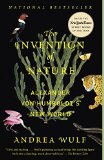Summary | Excerpt | Reviews | Beyond the Book | Readalikes | Genres & Themes | Author Bio

Critics' Opinion:
Readers' Opinion:
First Published:
Sep 2015, 496 pages
Paperback:
Oct 2016, 496 pages
 Book Reviewed by:
Book Reviewed by:
James Broderick
Buy This Book
After an hour of treacherous climbing, the ridge became a little less steep but now sharp rocks tore their shoes and their feet began to bleed. Then, suddenly, the fog lifted, revealing Chimborazo's white peak glinting in the sun, a little over 1,000 feet above them – but they also saw that their narrow ridge had ended. Instead, they were confronted by the mouth of a huge crevasse which opened in front of them. To get around it would have involved walking across a field of deep snow but by now it was 1 p.m. and the sun had melted the icy crust that covered the snow. When Montúfar gingerly tried to tread on it, he sank so deeply that he completely disappeared. There was no way to cross. As they paused, Humboldt took out the barometer again and measured their altitude at 19,413 feet. Though they wouldn't make it to the summit, it still felt like being on the top of the world. No one had ever come this high – not even the early balloonists.
Looking down Chimborazo's slopes and the mountain ranges in the distance, everything that Humboldt had seen in the previous years came together. His brother Wilhelm had long believed that Alexander's mind was made 'to connect ideas, to detect chains of things'. As he stood that day on Chimborazo, Humboldt absorbed what lay in front of him while his mind reached back to all the plants, rock formations and measurements that he had seen and taken on the slopes of the Alps, the Pyrenees and in Tenerife. Everything that he had ever observed fell into place. Nature, Humboldt realized, was a web of life and a global force. He was, a colleague later said, the first to understand that everything was interwoven as with 'a thousand threads'. This new idea of nature was to change the way people understood the world.
Humboldt was struck by this 'resemblance which we trace in climates the most distant from each other'. Here in the Andes, for example, grew a moss that reminded him of a species from the forests in northern Germany, thousands of miles away. On the mountains near Caracas he had examined rhododendron-like plants – alpine rose trees, as he called them – which were like those from the Swiss Alps. Later, in Mexico, he would find pines, cypresses and oaks that were similar to those that grew in Canada. Alpine plants could be found on the mountains of Switzerland, in Lapland and here in the Andes. Everything was connected.
For Humboldt, the days they had spent travelling from Quito and then climbing up Chimborazo had been like a botanical journey that moved from the Equator towards the poles – with the whole plant world seemingly layered one on top of the other as one ascended the mountains. The vegetation zones ranged from the tropical plants down in the valleys to the lichens that he had encountered near the snow line. Towards the end of his life, Humboldt often talked about understanding nature from 'a higher point of view' from which those connections could be seen; the moment when he had realized this was here, on Chimborazo. With 'a single glance', he suddenly saw the whole of nature laid out before him.
When they returned from Chimborazo, Humboldt was ready to formulate his new vision of nature. In the Andean foothills, he began to sketch his so-called Naturgemälde, an untranslatable German term that can mean a 'painting of nature' but it also implies a sense of unity or wholeness. It was, as Humboldt later explained, a 'microcosm on one page'. Unlike the scientists who had previously classified the natural world into tight taxonomic units along a strict hierarchy, filling endless tables with categories, Humboldt now produced a drawing.
'Nature was a living whole,' he later said, not a 'dead aggregate'. One single life, he said, had been poured over stones, plants, animals and mankind. It was this 'universal profusion with which life is everywhere distributed' that most impressed Humboldt. Even the atmosphere carried the kernels of future life – pollen, insect eggs and seeds. Life was everywhere and those 'organic powers are incessantly at work', he wrote. Humboldt was not so much interested in finding new isolated facts but in connecting them. Individual phenomena were only important 'in their relation to the whole', he explained. They were the parts that made the whole.
Excerpted from The Invention of Nature by Andrea Wulf. Copyright © 2015 by Andrea Wulf. Excerpted by permission of Knopf, a division of Random House LLC. All rights reserved. No part of this excerpt may be reproduced or reprinted without permission in writing from the publisher.





The House on Biscayne Bay
by Chanel Cleeton
As death stalks a gothic mansion in Miami, the lives of two women intertwine as the past and present collide.

The Flower Sisters
by Michelle Collins Anderson
From the new Fannie Flagg of the Ozarks, a richly-woven story of family, forgiveness, and reinvention.

The Funeral Cryer by Wenyan Lu
Debut novelist Wenyan Lu brings us this witty yet profound story about one woman's midlife reawakening in contemporary rural China.
Your guide toexceptional books
BookBrowse seeks out and recommends the best in contemporary fiction and nonfiction—books that not only engage and entertain but also deepen our understanding of ourselves and the world around us.